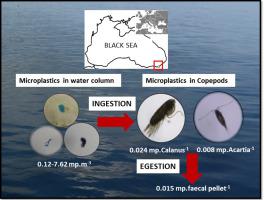Science of the Total Environment ( IF 9.8 ) Pub Date : 2021-10-16 , DOI: 10.1016/j.scitotenv.2021.150921 Ulgen Aytan 1 , F Başak Esensoy 1 , Yasemen Senturk 1

|
Ingestion and egestion of microplastics by copepods in the Black Sea was assessed for the first time. Composition and concentration of microplastics in the water column was also evaluated. Samples were collected from three stations (river mouth, coastal and open water) in the Southeastern Black Sea over the course of one year. Microplastic concentration in the water column ranged between 0.12 and 7.62 mp·m−3 (mean 2.04 ± 1.05 mp·m−3) with significantly higher concentrations in the river mouth. The most common types of microplastics were fibres, followed by films and fragments. A total of 11 colours of microplastics were found, being blue the most common colour. Analysis of 1126 C. euxinus and 1065 A. clausi, resulted in 26 and 9 microplastics being detected, respectively. This resulted in a microplastic ingestion of 0.024 ± 0.020 mp. Calanus−1 and 0.008 ± 0.006 mp. Acartia−1. Analysis of 351 faecal pellets, resulted 4 microplastics being found. The average size of ingested microplastics was greater in C. euxinus (0.100 mm ± 0.153 mm) than in A. clausi (0.062 mm ± 0.056 mm). Size of ingested microplastics was in the size range of natural preys of these copepods. Fragments were the most common type of ingested microplastics, followed by films and fibres. The colour of ingested particles was black, blue and red. Our results show that the copepods and the pelagic environment of the Black Sea are contaminated by microplastics. Critical functions of zooplankton in this degraded ecosystem are under risk and zooplankton are likely to act as a vector for the transfer of microplastics and associated toxic chemicals to upper trophic levels including humans in the Black Sea.
中文翻译:

黑海桡足类对微塑料的摄取和消化
首次评估了黑海桡足类动物对微塑料的摄入和消化。还评估了水柱中微塑料的组成和浓度。在一年的时间里,从黑海东南部的三个站点(河口、沿海和开放水域)收集了样本。水体中的微塑料浓度介于 0.12 和 7.62 mp·m -3(平均 2.04 ± 1.05 mp·m -3)之间,河口中的浓度明显更高。最常见的微塑料类型是纤维,其次是薄膜和碎片。共发现了 11 种颜色的微塑料,其中蓝色是最常见的颜色。1126 C. euxinus和 1065 A. clausi 的分析,分别检测到 26 种和 9 种微塑料。这导致微塑料摄入量为 0.024 ± 0.020 mp。Calanus - 1和 0.008 ± 0.006 mp。阿卡蒂亚- 1。分析了 351 个粪便颗粒,结果发现了 4 个微塑料。C. euxinus (0.100 mm ± 0.153 mm)中摄入的微塑料的平均尺寸大于A. clausi(0.062 毫米 ± 0.056 毫米)。摄入的微塑料的大小在这些桡足类天然猎物的大小范围内。碎片是最常见的摄入微塑料类型,其次是薄膜和纤维。摄入颗粒的颜色为黑色、蓝色和红色。我们的研究结果表明,黑海的桡足类动物和远洋环境受到微塑料的污染。在这个退化的生态系统中,浮游动物的关键功能面临风险,浮游动物很可能成为将微塑料和相关有毒化学物质转移到包括黑海人类在内的上层营养水平的载体。



























 京公网安备 11010802027423号
京公网安备 11010802027423号